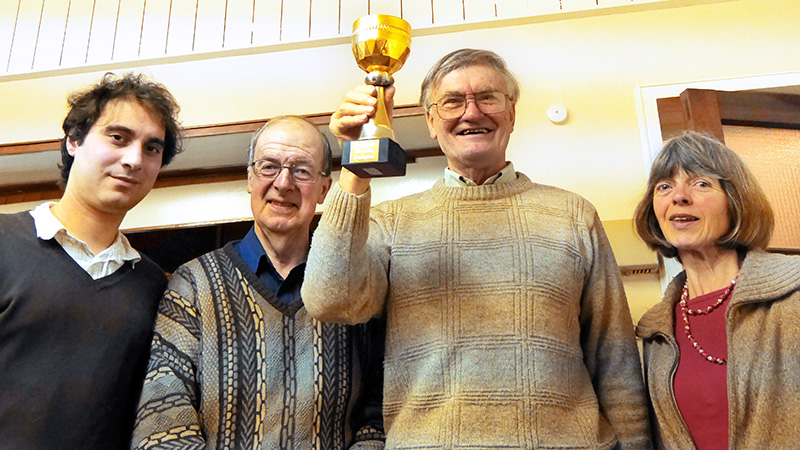Custard powder, teabags, Night Nurse and damsons were some of the flavours detected in the entries at the first Rye News sloe gin competition held on January 26.
Judges Margaret O’Neill – a real Ryer, born and bred – and Danny Delenio, owner of Olde Worlde Wines on Cinque Ports Street, swished, sipped and nosed but didn’t spit their way through eight home-made offerings. The contestants watched as the shot glasses were replenished frequently as they went under interrogation one by one at The Club on Market Road, Rye. Dennis Leeds-George, who masterminded the whole affair but failed to pick any sloes in time, was the adjudicating judge and prepared blind tastings for the selected experts.
The examples varied hugely and the judges didn’t decide any marks until they’d tasted the lot. To make it fairer, this season’s vintages – after being correctly identified by the judges – were judged separately. This left five, their date of birth ranging from 2008 to 2013.
- Trophy winner: nice brick red colour, good amount of tannins, not as sharp as some, smoother, sweeter, better balance ratio than others, hint of those teabags. Margaret Bird 2012
- Close second: plum red colour, quite strong, good age, finish bitter and short, good tannins, not too sweet (she’d added vodka!). Margaret O’Neill 2011
- Third: very good, quite matured, potent, very balanced, not enough tannins, plum jam, long after taste, medicinal (cough mixture), like a Bordeaux that’s been kept too long. Danny Delenio’s mate 2013
- Just off the podium: attractive amber colour, good acidity, hint of almonds, but too sweet. Margaret O’Neill 2008
- Lovely aperitif: amber brown colour, more like a sherry on the nose, tasted more like a Madeira/fortified wine, almonds and walnuts, not bitter but excessively dry and barely a hint of sloes. Sue Saffery 2011
And among the 2014 vintages, all from the same cellar, the one with the most sugar – still far less than any recipes suggested – was the winner. Delenio admitted to having had a very good example at home, so good that he and his wife had drunk it all.
- First prize: slips down well and not overloaded with sugar, classical, nice claret-red colour, good bitterness. Jane Nunn
- Second: jam-fruits nose, marzipan, custard powder (spot on, I added vanilla pods), bitter, tannins, needs to age, clumsy and unbalanced but good potential. Jane Nunn
- Third: nice colour, no smell on the nose, similar in aroma to the trophy winner (teabags again – wrong! as my husband popped in Pontefract Cakes from Tony Moxon’s sweet shop in the High Street), less clumsy, more maturity and more palatable now than the vanilla one but less potential. Tony Nunn
Judging complete, all those present got down to tasting and comparing whatever the judges had left. All agreed that the contest should be an annual event and Delenio suggested it might be held at his own premises next time. Plenty of reminders will appear in Rye News so that we all remember to pick sloes in good time.
The evening ended with Kenneth Bird receiving the trophy from Leeds-George – undeservedly, as it was his wife Margaret who made it.
Recipe for success?
Many ideas about recipes were exchanged and, the following day, the Birds came across a small booklet, Home Made Country Wines – Tried and Tested Recipes collected by the Farmers Weekly. It sold for 20p in 1973 and they suspect rather less when first published in 1955. They admit they have not tried the recipe submitted by Mrs K Cowpe of Sutton Coldfield so can’t recommend it, but it was clearly a winner back in the 1950s. The quantities do sound excessive, like Mrs Beaton’s, let alone the capital investment in all that gin! Their advice would be to store it in a dark place for five years and then it will be vintage, with a much better chance of winning a future competition.
1 gallon gin
3 oz bitter almonds
8 oz granulated sugar
6 pints sloes
Mix all ingredients and put in a 2-gallon jar. Cork and shake the jar three times a week. Store for two months, then syphon and bottle – and leave for five years, if you can.
Photos: Tony Nunn



